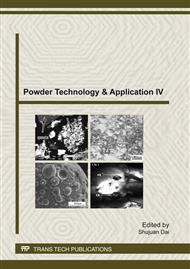[1]
Y.Q. Lu and Y Gao, The development of pharmacology research in Chinese medicine herb compounds modernization, New Med Clin Pharm Res Chin Med Herb, Vol.13(2002),pp.59-61.
Google Scholar
[2]
LianWei Yang, Physicochemical characterization of Baizhi particles by ultrafine pulverizatio. International journal of minerals metallurgy and materials. Vol.18 (2011), p.247
Google Scholar
[3]
W.F. Li, J.G. Jiang and J. Chen, Chinese medicine and its modernization demands, Arch. Med. Res. Vol.39(2008), pp.246-251.
Google Scholar
[4]
LianWei Yang, Guo-Sheng Gai. Physicochemical characterization of qianghuo particles by ultrafine pulverization. Advanced Material Research. Vol.92(2010), p.147
DOI: 10.4028/www.scientific.net/amr.92.147
Google Scholar
[5]
X. Lou and Z. Chen, Modernization of traditional Chinese medicine, Medical Journal of China, Vol.86(2006), pp.68-70.
Google Scholar
[6]
S.Grano, The critical importance of the grinding environment on fine particle recovery in flotation, Minerals Engineering, Vol.21(2008), pp.1-4.
DOI: 10.1016/j.mineng.2008.10.008
Google Scholar
[7]
Lianwei Yand , Ruijie Wang, Miao Jia . Physicochemical characterization of Chuanxiong particles by ultrafine pulverization. Applied Mechanics and Materials. Vol.55 (2011) ,p.1725.
DOI: 10.4028/www.scientific.net/amm.55-57.1725
Google Scholar
[8]
L.W. Yang, X.Y. Zhao and G.S. Gai, The impact of ultrafine pulverization on Chinese traditional medicine, [in] proc.1th Int. China International Powder Technology & Application Forum, Beijing, (2008), p.11.
Google Scholar
[9]
L.W. Yang and J.X Fu, Ultrafine pulverization technology and application, [in] proc.1th Int. China International Powder Technology & Application Forum, Beijing, (2008), p.16.
Google Scholar
[10]
L.W. Yang and G.S. Gai. Biological powder technology and the modernization of Chinese traditional medicine, China powder technology, Vol.13(2007), pp.126-131.
Google Scholar
[11]
P.Y. Ma, Z.Y Fu, Modification of physicochemical and medicinal characterization of Liuwei Dihuang powders by ultrafine grinding, Powder Technology, Vol.191(2009), p.194–199.
DOI: 10.1016/j.powtec.2008.10.008
Google Scholar
[12]
H.B. Xu, X.L. Yang and C.S. Xie, The application of nano technology on the study of the Traditional Chinese Medicine, J. Chin. Pharm U, Vol.32(2001), pp.161-165.
Google Scholar
[13]
M. Meier, E. John and D. Wieckhusen, Influence of mechanical properties on impact fracture: Prediction of the milling behavior of pharmaceutical powder by nanoindentation, Powder Technology, Vol.188 (2009), pp.301-313.
DOI: 10.1016/j.powtec.2008.05.009
Google Scholar
[14]
S.L. Liu and H. Wang, Advantages and application development of ultrafine pulverization, Drying technology and equipment, Vol.5(2007), pp.5-9.
Google Scholar


